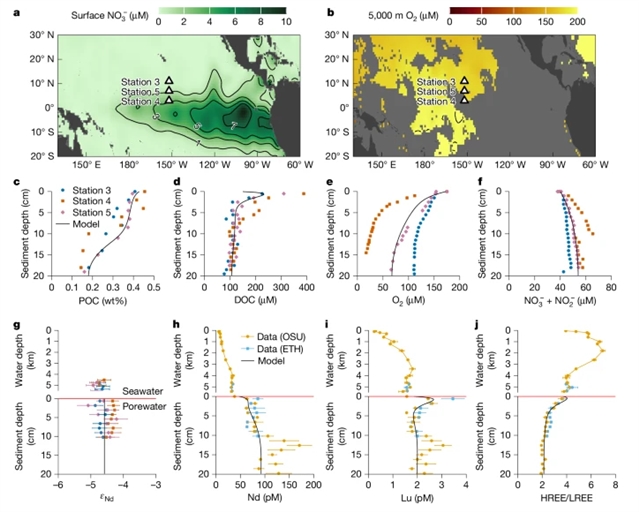
美国俄勒冈州立大学Brian A. Haley团队揭示了深海海底是海洋痕量金属生物地球化学循环的关键驱动因素。这一研究成果于2025年6月11日发表在《自然》杂志上。
微量元素和同位素(TEIs)对海洋生物很重要,是研究海洋过程的重要工具。关于海洋TEI循环,出现了两种不同的框架:可逆清除有利于水柱对TEI分布的控制,海底边界交换强调水柱生物地球化学的沉积印记。这两种观点导致了对TEI行为的不同解释。研究组使用稀土元素和钕同位素作为粒子清除和边界交换的示例示踪剂。将这些数据与颗粒循环和沉积物成岩作用模型相结合,提出了海洋TEI循环的一般框架。
结果发现,对于对氧化锰的亲和力大于生物颗粒的元素,清除是整个水柱的净汇,这与可逆清除的普遍假设相反。在这种情况下,底栖通量支持元素浓度随着水深的增加而增加。这种沉积源由两部分组成:一部分是从水柱颗粒清除的元素中回收的,另一部分是通过沉积物内部的海洋硅酸盐风化新引入水柱的。深海含氧成岩作用驱动了这种底栖物源,并通过海底几何形状和底部强化湍流混合对水柱生物地球化学产生了强烈影响。该研究结果证实了自生矿物在水柱循环中的作用,这些矿物往往被生物颗粒所掩盖,并表明通常被视为不活跃的深海海底是生物地球化学转化的重点。
附:英文原文
Title: Abyssal seafloor as a key driver of ocean trace-metal biogeochemical cycles
Author: Du, Jianghui, Haley, Brian A., McManus, James, Blaser, Patrick, Rickli, Jrg, Vance, Derek
Issue&Volume: 2025-06-11
Abstract: Trace elements and isotopes (TEIs) are important to marine life and are essential tools for studying ocean processes1. Two different frameworks have arisen regarding marine TEI cycling: reversible scavenging favours water-column control on TEI distributions2,3,4,5, and seafloor boundary exchange emphasizes sedimentary imprints on water-column biogeochemistry6,7. These two views lead to disparate interpretations of TEI behaviours8,9,10. Here we use rare earth elements and neodymium isotopes as exemplar tracers of particle scavenging11 and boundary exchange6,7,12. We integrate these data with models of particle cycling and sediment diagenesis to propose a general framework for marine TEI cycling. We show that, for elements with greater affinity for manganese oxide than biogenic particles, scavenging is a net sink throughout the water column, contrary to a common assumption for reversible scavenging3,13. In this case, a benthic flux supports increasing elemental concentrations with water depth. This sedimentary source consists of two components: one recycled from elements scavenged by water-column particles, and another newly introduced to the water column through marine silicate weathering inside sediment8,14,15. Abyssal oxic diagenesis drives this benthic source, and exerts a strong influence on water-column biogeochemistry through seafloor geometry and bottom-intensified turbulent mixing16,17. Our findings affirm the role of authigenic minerals, often overshadowed by biogenic particles, in water-column cycling18, and suggest that the abyssal seafloor, often regarded as inactive, is a focus of biogeochemical transformation19,20.
DOI: 10.1038/s41586-025-09038-3
Source: https://www.nature.com/articles/s41586-025-09038-3
Nature:《自然》,创刊于1869年。隶属于施普林格·自然出版集团,最新IF:69.504
官方网址:http://www.nature.com/
投稿链接:http://www.nature.com/authors/submit_manuscript.html
